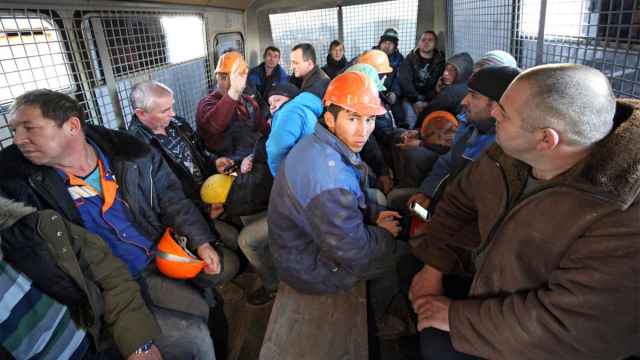Сотка: one hundred square meters
We’ve gotten a bit lax lately in the Word’s Worth office, which means just one thing: it’s time for a Friday pop quiz.
Here’s one: What’s a пуд? a) a black cloak with hood worn by the horse-riding henchmen of Ivan the Terrible; b) a dessert made with stewed fruits and porridge, from the English word “pudding”; c) a large amount of salt eaten together with a person, used in an expression of friendship; d) none of the above; e) all of the above; f) I hate this language.
If you answered (c) — you win a large pile of salt to share with your besties.
You also win the satisfaction of knowing that пуд is another old Russian measure, today equal to 16 kilograms (about 35 pounds).
Like all ancient Russian forms of measure, there is no way to know how much one пуд originally weighed, although we do know that its weight changed over the centuries. In 1835 there was an imperial decree that standardized Russian measures of weight, length, volume and area to English measures, which altered whatever the previous values were. Later, in 1899, another state decree permitted the use of the metric system. For a couple of decades пуд lived in conjugal measurement bliss with килограмм (kilogram), until the metric system was made law in the Russian republic in 1918. It took another seven years before it became law throughout the U.S.S.R. When that happened, there was another standardization of native Russian measures, this time to metrical values.
I’ve learned in my reading that at one time один пуд (one pood) was equal to: 40 больших гривенок или 80 малых (40 large grivenkas or 80 small ones). I’ve also discovered that 10 пудов (10 poods) were the equivalent of один берковец (one berkovets), another kind of weight. This tells me absolutely nothing, since I have no idea how much the grivenka and berkovets weighed.
Finding out is tough. In different centuries — and even different regions — the weights had different values. Did you need a big wagon or a rucksack to carry home your пуд соли (pood of salt)? Tell me the date and place, and then we can start to do the conversion.
But to be honest, I don’t really care. I just like saying the names: пуд, малая гривенка, берковец…
And I like the expression пуд соли съели (literally “we ate a pood of salt” together), which means that you’ve gone through thick and thin with someone. Another pood expression that has withstood the metric system is спор пудов с аршинами (literally “an argument between poods and arshins,” that is, between a measure of weight and measure of length). This is something like “comparing apples and oranges.”
Another weight measure that is a bit of a surprise to find in Russia is фунт (pound), which was used in the far western parts of the country as far back as the 14th century. Until the 17th century фунт was equal to one гривенка and the two were used interchangeably. Then the фунт took over and was used up until 1918. You can find it in old cookbooks and in expressions like это тебе не фунт изюму (literally “that’s not a pound of raisins for you”) — that’s not something to laugh at, that’s no joke.
The length measures include something you can still occasionally see on the roadways: верста, or верстовой столб (verst, verst post) — stone markers on roads between towns or cities. Two things about versts are a headache. The first is the length. In various centuries and various places верста was 500, 700, or 1,000 саженей (500, 700 or 1,000 sazhens), so if you want to know how far an estate was from a town in a 19th century novel, you have to do a lot of research. Now it is just over a kilometer (1066.8 meters).
The other headache with this word is stress and pronunciation. Singular — верстА, plural — вёрсты.
I’ve come to think of all these changing measuring systems — sometimes coexisting, sometimes taking over from one another — as parallel measuring universes. Пуд, верста and фунт in Murmansk existed in one world, while another пуд, верста and фунт existed in Yaroslavl.
This is very easy for me to imagine, since as an American living in Russia, I also live in two alternate measurement realities. Oddly, they don’t intersect. That is, I know, for example, what jacket to put on when it’s 12 degrees Celsius or 50 degrees Fahrenheit, but I never convert the temperatures and have no idea which one is higher.
The standard city driving speed of 60 километров в час (60 kilometers an hour) seems fast, but 37 miles per hour is slow-poke speed. Nothing will convince me that they are the same.
Шесть соток (six sotkas, or 600 square meters) was once the standard small plot of land in the Soviet Union. I know what it looks like with a house on it: a bit of grass in front, couple meters on the sides, and a backyard big enough for a vegetable garden, kiddie pool, grill and table. Seems fine to me.
So I simply refuse to believe that six sotkas are .15 acre, and you need 20 to reach half an acre.
I do, however, want to buy one пуд соли just so I can imagine eating it over a lifetime.
Michele A. Berdy is a Moscow-based translator and interpreter, author of “The Russian Word’s Worth,” a collection of her columns. Follow her on Twitter @MicheleBerdy.






